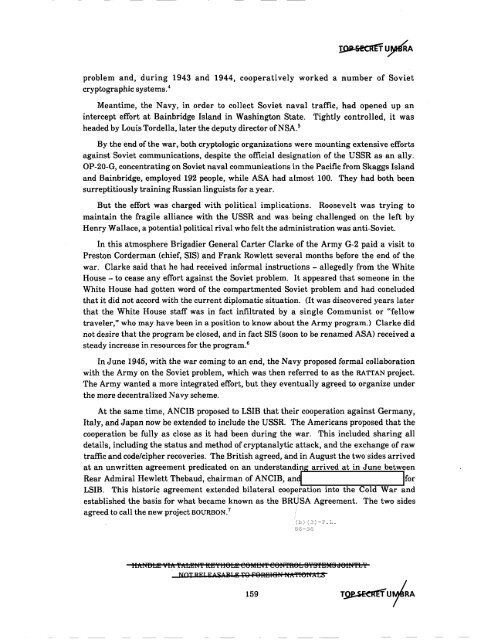American Cryptology during the Cold War - The Black Vault
American Cryptology during the Cold War - The Black Vault
American Cryptology during the Cold War - The Black Vault
You also want an ePaper? Increase the reach of your titles
YUMPU automatically turns print PDFs into web optimized ePapers that Google loves.
problem and, <strong>during</strong> 1943 and 1944, cooperatively worked a number of Soviet<br />
cryptographic systems. 4<br />
Meantime, <strong>the</strong> Navy, in order to collect Soviet naval traffic, had opened up an<br />
intercept effort at Bainbridge Island in Washington State. Tightly controlled, it was<br />
headed by Louis Tordella, later <strong>the</strong> deputy director ofNSA,5<br />
By <strong>the</strong> end of <strong>the</strong> war, both cryptologic organizations were mounting extensive efforts<br />
against Soviet communications, despite <strong>the</strong> official designation of <strong>the</strong> USSR as an ally.<br />
OP-20-G, concentrating on Soviet naval communications in <strong>the</strong> Pacific from Skaggs Island<br />
and Bainbridge, employed 192 people, while ASA had almost 100. <strong>The</strong>y had both been<br />
surreptitiously training Russian linguists for a year.<br />
But <strong>the</strong> effort was charged with political implications. Roosevelt was trying to<br />
maintain <strong>the</strong> fragile alliance with <strong>the</strong> USSR and was being challenged on <strong>the</strong> left by<br />
Henry Wallace, a potential political rival who felt <strong>the</strong> administration was anti-Soviet.<br />
In this atmosphere Brigadier General Carter Clarke of <strong>the</strong> Army G-2 paid a visit to<br />
Preston Corderman (chief, SIS) and Frank Rowlett several months before <strong>the</strong> end of <strong>the</strong><br />
war. Clarke said that he had received informal instructions - allegedly from <strong>the</strong> White<br />
House - to cease any effort against <strong>the</strong> Soviet problem. It appeared that someone in <strong>the</strong><br />
White House had gotten word of <strong>the</strong> compartmented Soviet problem and had concluded<br />
that it did not accord with <strong>the</strong> current diplomatic situation. (It was discovered years later<br />
that <strong>the</strong> White House staff was in fact infiltrated by a single Communist or "fellow<br />
traveler," who may have been in a position to know about <strong>the</strong> Army program.) Clarke did<br />
not desire that <strong>the</strong> program be closed, and in fact SIS (soon to be renamed ASA) received a<br />
steady increase in resources for <strong>the</strong> program. 6<br />
In June 1945, with <strong>the</strong> war coming to an end, <strong>the</strong> Navy proposed formal collaboration<br />
with <strong>the</strong> Army on <strong>the</strong> Soviet problem, which was <strong>the</strong>n referred to as <strong>the</strong> RATTAN project.<br />
<strong>The</strong> Army wanted a more integrated effort, but <strong>the</strong>y eventually agreed to organize under<br />
<strong>the</strong> more decentralized Navy scheme.<br />
At <strong>the</strong> same time, ANCIB proposed to LSIB that <strong>the</strong>ir cooperation against Germany,<br />
Italy, and Japan now be extended to include <strong>the</strong> USSR. <strong>The</strong> <strong>American</strong>s proposed that <strong>the</strong><br />
cooperation be fully as close as it had been <strong>during</strong> <strong>the</strong> war. This included sharing all<br />
details, including <strong>the</strong> status and method of cryptanalytic attack, and <strong>the</strong> exchange of raw<br />
traffic and code/cipher recoveries. <strong>The</strong> British agreed, and in August <strong>the</strong> two sides arrived<br />
at an unwritten agreement predicated on an understanding arrived at in June between<br />
Rear Admiral Hewlett <strong>The</strong>baud, chairman of ANCIB, an1<br />
Ifor<br />
LSIB. This historic agreement extended bilateral cooperation into <strong>the</strong> <strong>Cold</strong> <strong>War</strong> and<br />
established <strong>the</strong> basis for what became known as <strong>the</strong> BRUSA Agreement. <strong>The</strong> two sides<br />
agreed to call <strong>the</strong> new project BOURBON. 7<br />
(b) (3)-P.L.<br />
86-36<br />
Ih\!fBLfJ VIA 'fALl!JN'f t{fJY1I8LfJ 68MU,,'f 68N'fft8L S'[S'ffJMSd8m'fLY<br />
NOT REI F A ~ AiU 1'9 F9REH8N' r.qA'fI8NALS<br />
159
















